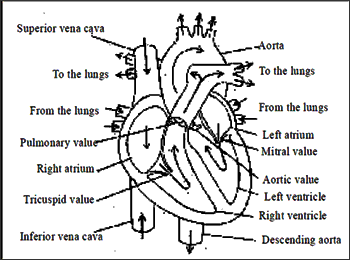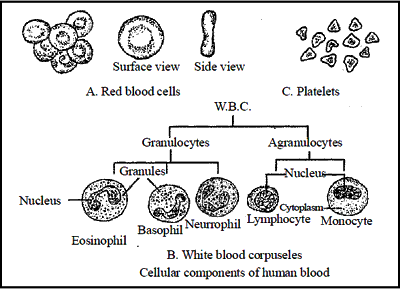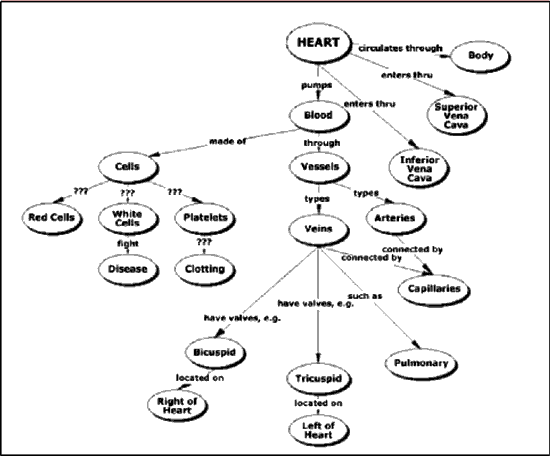(HOT) UPSC Current Affairs 2025 PDF
NEW! The Gist (NOV-2025) | E-BOOKS
(IGP) IAS Pre: GS - Science & Technology : Biology - The Circulatory System
Biology
The Circulatory System
INTRODUCTION
Living things must be capable of transporting nutrients, wastes and gases to and from cells. Single-celled organisms use their cell surface as a point of exchange with the outside environment. Multicellular organisms have developed transport and circulatory systems to deliver oxygen and food to cells and remove carbon dioxide and metabolic wastes.
CIRCULATORY SYSTEMS IN SINGLE CELLED ORGANISMS
Single-celled organisms use their cell surface as a point of exchange with the outside environment. Sponges are the simplest animals, yet even they have a transport system. Seawater is the medium of transport and is propelled in and out of the sponge by ciliary action. Simple animals, such as the hydra and planaria lack specialized organs such as hearts and blood vessels, instead using their skin as an exchange point for materials. This, however, limits the size an animal can attain. To become larger, they need specialized organs and organ systems.
CIRCULATORY SYSTEMS IN MULTICELLULAR ORGANISMS
Multicellular animals do not have most of their cells in contact with the external environment and so have developed circulatory systems to transport nutrients, oxygen, carbon dioxide andmetabolicwastes.Components of the circulatory system include
i. Blood: a connective tissue of liquid plasma and cells
ii. Heart: a muscular pump to move the blood
iii. Blood vessels: arteries, capillaries and veins that deliver blood to all tissues
TYPES OF CIRCULATORY SYSTEMS
(a) The open circulatory system The open circulatory system, examples molluscs and arthropods. Open circulatory systems (evolved in insects, mollusks and other invertebrates) pump blood into a hemocoel with the blood diffusing back to the circulatory system between cells. Blood is pumped by a heart into the body cavities, where tissues are surrounded by the blood. The resulting blood flow is sluggish.
(b) Closed circulatory system Vertebrates, and a few invertebrates, have a closed circulatory system. Closed circulatory systems (evolved in echinoderms and vertebrates) have the blood closed at all times within vessels of different size and wall thickness. In this type of system, blood is pumped by a heart through vessels, and does not normally fill body cavities. Blood flow is not sluggish. Hemoglobin causes vertebrate blood to turn red in the presence of oxygen; but more importantly hemoglobin molecules in blood cells transport oxygen. The human closed circulatory system is sometimes called the cardiovascular system. The lymphatic circulation, which is also secondary circulatory system collects fluid and cells and returns them to the cardiovascular system.
VERTEBRATE CARDIOVASCULAR SYSTEM
The vertebrate cardiovascular system includes a heart, which is a muscular pump that contracts to propel blood out to the body through arteries, and a series of blood vessels.
The upper chamber of the heart, the atrium (pl. atria), is where the blood enters the heart. Passing through a valve, blood enters the lower chamber, the ventricle.
Contraction of the ventricle forces blood from the heart through an artery. The heart muscle is composed of cardiac muscle cells. Arteries are blood vessels that carry blood away from heart. Arterial walls are able to expand and contract. Arteries have three layers of thick walls. Smooth muscle fibers contract, another layer of connective tissue is quite elastic, allowing the arteries to carry blood under high pressure The aorta is the main artery leaving the heart. The pulmonary artery is the only artery that carries oxygen-poor blood. The pulmonary artery carries deoxygenated blood to the lungs. In the lungs, gas exchange occurs, carbon dioxide diffuses out, oxygen diffuses in Arterioles are small arteries that connect larger arteries with capillaries. Small arterioles branch into collections of capillaries known as capillary beds.
|
Capillaries, are thin-walled blood vessels inwhich gas exchange occurs. |
capillaries by passing through or between the cells that line the capillary. The extensive network of capillaries in the human body is estimated at between 50,000 and 60,000 miles long.Thoroughfare channels allowblood to bypass a capillary bed. These channels can open and close by the action of muscles that control blood flow through the channels. Blood leaving the capillary beds flows into a progressively larger series of venules that in turn join to form veins.Veins carry blood fromcapillaries to the heart.With the exception of the pulmonary veins, blood in veins is oxygenpoor. The pulmonary veins carry oxygenated blood from lungs back to the heart.Venules are smaller veins that gather blood fromcapillary beds into veins.Pressure in veins is low, so veins depend on nearby muscular contractions to move blood along. The veins have valves that prevent back-flow of blood Blood pressure: Ventricular contraction propels blood into arteries under great pressure. Blood pressure is measured in mm of mercury; healthy young adults should have pressure of ventricular systole of 120mm, and 80 mm at ventricular diastole. |
|
|
|
|
Higher pressures (human 120/80 as compared to a 12/ 1 in lobsters) mean the volume of blood circulates faster (20 seconds in humans, 8 minutes in lobsters). As blood gets farther from the heart, the pressure likewise decreases. Each contraction of the ventricles sends |
pressure through the arteries. Elasticity of lungs helps keep pulmonary pressures low. Systemic pressure is sensed by receptors in the arteries and atria. Nerve messages from these sensors communicate conditions to the medulla in the brain. Signals from the medulla regulate blood pressure. |
VERTEBRATE VASCULAR SYSTEMS
Humans, birds, and mammals have a four-chambered heart that completely separates oxygen-rich and oxygendepleted blood. Fish have a two-chambered heart in which a single-loop circulatory pattern takes blood from the heart to the gills and then to the body.
Amphibians have a three-chambered heart with two atria and one ventricle. A loop from the heart goes to the pulmonary capillary beds, where gas exchange occurs. Blood then is returned to the heart.Blood exiting the ventricle is diverted, some to the pulmonary circuit, some to systemic circuit. The disadvantage of the three-chambered heart is the mixing of oxygenated and deoxygenated blood.
Some reptiles have partial separation of the ventricle. Other reptiles, plus, all birds and mammals, have a fourchambered heart, with complete separation of both systemic and pulmonary circuits.
THE HEART
The heart is a muscular structure that contracts in a rhythmic pattern to pump blood. Hearts have a variety of forms:
Chambered hearts inmollusks and vertebrates, Tubular hearts of arthropods, and aortic arches of annelids. Accessory hearts are used by insects to boost or supplement the main heart’s actions. Fish, reptiles, and amphibians have lymph hearts that help pump lymph back into veins.
The basic vertebrate heart, such as in has two chambers.An auricle is the chamber of the heart where blood is received from the body. A ventricle pumps the blood it gets through a valve from the auricle out to the gills through an artery.
Amphibians have a three-chambered heart: Two atria emptying into a single common ventricle. Some species have a partial separation of the ventricle to reduce the mixing of oxygenated (coming back from the lungs) and deoxygenated blood (coming in from the body).

Two sided or two chambered hearts permit pumping at higher pressures and the addition of the pulmonary loop permits blood to go to the lungs at lower pressure yet still go to the systemic loop at higher pressures.
Establishment of the four-chambered heart, along with the pulmonary and systemic circuits, completely separates oxygenated from deoxygenated blood. This allows higher the metabolic rates needed by warm-blooded birds and mammals.
THE HUMAN HEART
The human heart is a two-sided, four-chambered structure with muscular walls. An atrioventricular (AV) valve separates each auricle from ventricle. A semilunar (also known as arterial) valve separates each ventricle from its connecting artery.
The heart beats or contracts approximately 70 times per minute. The human heart will undergo over 3 billion contraction cycles during a normal lifetime.
The cardiac cycle The cardiac cycle consists of two parts: systole (contraction of the heart muscle) and diastole (relaxation of the heart muscle). Atria contract while ventricles relax. The pulse is a wave of contraction transmitted along the arteries.
Valves in the heart open and close during the cardiac cycle. Heart muscle contraction is due to the presence of nodal tissue in two regions of the heart. The SA node (sinoatrial node) initiates heartbeat. The AV node (atrioventricular node) causes ventricles to contract. The AV node is sometimes called the pacemaker since it keeps heartbeat regular. Heartbeat is also controlled by nerve messages originating from the autonomic nervous system.
Blood flows through the heart from veins to atria to ventricles out by arteries. Heart valves limit flow to a single direction One heartbeat, or cardiac cycle, includes atrial contraction and relaxation, ventricular contraction and relaxation, and a short pause.
Normal cardiac cycles (at rest) take 0.8 seconds Blood from the body flows into the vena cava, which empties into the right atrium. At the same time, oxygenated blood from the lungs flows fromthe pulmonary vein into the left atrium. The muscles of both atria contract, forcing blood downward through each AV valve into each ventricle.
Diastole is the filling of the ventricles with blood. Ventricular systole opens the SL valves, forcing blood out of the ventricles through the pulmonary artery or aorta. The sound of the heart contracting and the valves opening and closing produces a characteristic “lub-dub” sound. Lub is associated with closure of the AV valves, dub is the closing of the SL valves. Human heartbeats originate from the sinoatrial node (SA node) near the right atrium. Modified muscle cells contract, sending a signal to other muscle cells in the heart to contract. The signal spreads to the atrioventricular node (AV node). Signals carried from the AV node, slightly delayed, through bundle of His fibers and Purkinjie fibers cause the ventricles to contract simultaneously. Heartbeats are coordinated contractions of heart cardiac cells. When two or more of such cells are in proximity to each other their contractions synch up and they beat as one. An electrocardiogram(ECG) measures changes in electrical potential across the heart, and can detect the contraction pulses that pass over the surface of the heart ECGs are useful in diagnosing heart abnormalities.
DISEASES OF THE HEART AND CARDIOVASCULAR SYSTEM HEART ATTACK
Cardiac muscle cells are serviced by a system of coronary arteries. During exercise the flow through these arteries is up to five times normal flow. Blocked flow in coronary arteries can result in death of heart muscle, leading to a heart attack.
Blockage of coronary arteries. is usually the result of gradual buildup of lipids and cholesterol in the inner wall of the coronary artery.Occasional chest pain, angina pectoralis, can result during periods of stress or physical exertion. Angina indicates oxygen demands are greater than capacity to deliver it and that a heart attack may occur in the future. Heart muscle cells that die are not replaced since heart muscle cells do not divide. Heart disease and coronary artery disease are the leading causes of death tody. Hypertension, high blood pressure (the silent killer), occurs when blood pressure is consistently above 140/90. Causes in most cases are unknown, although stress, obesity, high salt intake, and smoking can add to a genetic predisposition. Luckily, when diagnosed, the condition is usually treatable with medicines and diet/exercise.
THE VASCULAR SYSTEM
Two main routes for circulation are the pulmonary (to and fromthe lungs) and the systemic (to and fromthe body). Pulmonary arteries carry blood from the heart to the lungs. In the lungs gas exchange occurs. Pulmonary veins carry blood from lungs to heart. The aorta is the main artery of systemic circuit. The vena cavae are the main veins of the systemic circuit. Coronary arteries deliver oxygenated blood, food, etc. to the heart.
Animals often have a portal system, which begins and ends in capillaries, such as between the digestive tract and the liver. Fish pump blood fromthe heart to their gills, where gas exchange occurs, and then on to the rest of the body. Mammals pump blood to the lungs for gas exchange, then back to the heart for pumping out to the systemic circulation. Blood flows in only one direction.
BLOOD

Blood is a bright red viscous fluidwhich flows through all the vessels except the lymph vessels. It constitutes 8% of the total body weight. Blood is composed of two portions: formed elements(cell and cell like structures) ad plasma (liquid containing dissolved substances).
Plasma:
- Plasma is the liquid component of the blood. Mammalian blood consists of a liquid (plasma) and a number of cellular and cell fragment components.
- Plasma is about 60 % of a volume of blood; cells and fragments are 40%. Plasma has 90% water and 10% dissolved materials including proteins, glucose, ions, hormones, and gases.
- It acts as a buffer, maintaining pH near 7.4. Plasma contains nutrients, wastes, salts, proteins, etc. Proteins in the blood aid in transport of large molecules such as cholesterol.
- Formed elements:
(a) Red blood cells
- Red blood cells, also known as erythrocytes, are flattened, doubly concave cells about 7 μm in diameter that carry oxygen associated in the cell’s hemoglobin.
- Mature erythrocytes lack a nucleus. They are small, 4 to 6 million cells per cubic millimeter of blood, and have 200 million hemoglobinmolecules per cell.
- Humans have a total of 25 trillion red blood cells (about 1/3 of all the cells in the body).
- Red blood cells are continuously manufactured in red marrow of long bones, ribs, skull, and vertebrae.
- Life-span of an erythrocyte is only 120 days, after which they are destroyed in liver and spleen.
- Iron from hemoglobin is recovered and reused by red marrow. The liver degrades the heme units and secretes them as pigment in the bile, responsible for the color of feces.
- Each second two million red blood cells are produced to replace the dead red blood cells.
(b) White Blood Cells
White blood cells, also known as leukocytes, are larger than erythrocytes, have a nucleus, and lack hemoglobin. They function in the cellular immune response. White blood cells (leukocytes) are less than 1% of the blood’s volume. There are five types of leukocytes, which are important components of the immune system.
(a) Neutrophils enter the tissue fluid by squeezing through capillarywalls and phagocytozing foreign substances
(b) Macrophages release white blood cell growth factors, causing a population increase for white blood cells.
(c) Lymphocytes fight infection.
(d) T-cells attack cells containing viruses.
(e) B-cells produce antibodies. Antigen-antibody complexes are phagocytized by a macrophage. White blood cells can squeeze through pores in the capillaries and fight infectious diseases in intestinal areas
(c) Platelets
- Platelets result from cell fragmentation and are involved with clotting.
- Platelets are cell fragments that bud off megakaryocytic in bone marrow. They carry chemicals essential to blood clotting.
- Platelets survive for 10 days before being removed by the liver and spleen
- There are 150,000 to 300,000 platelets in each milliliter of blood.
-
Platelets stick and adhere to tears in blood vessels; they also release clotting factors.A hemophiliac’s blood cannot clot. Providing correct proteins (clotting factors) has been a common method of treating hemophiliacs. It has also led to HIV transmission due to the use of transfusions and use of contaminated blood products.
THE LYMPHATIC SYSTEM
Water and plasma are forced from the capillaries into intracellular spaces. This interstitial fluid transports materials between cells.Most of this fluid is collected in the capillaries of a secondary circulatory system, the lymphatic system. Fluid in this system is known as lymph. Lymph flows from small lymph capillaries into lymph vessels that are similar to veins in having valves that prevent backflow.
CIRCULATING SYSTEM
Difference between Arteries and Veins Arteries
- blood flows away from the heart.
- blood flows with a jerk and with great pressure.
- they always carry oxygenated blood except the pulmonary artery.
- walls of arteries are thicker
- valves are absent
- their walls are elastic and muscular
- non collapsible
Veins
- blood flows toward heart.
- blood flows smoothly and with less pressure.
- they always carry deoxygenated blood except the pulmonary vein
- walls of veins are thinner.
- semi lunar valves are present
- they are superficial
- their walls are non elastic and fibrous
- collapsible
| Erythrocyte | Leucocyte | Platelet | |
| Life span Formed | 120 days Red bone marrow lymph marrow nodes Liver and spleen Absent in mature erythrocytes Carries oxygen and forms oxyyhaemoglobin (bright red) carries carbon di oxide | Few hours in few days Red bone marrow
liver by bacteria Nucleated Absent produce antibodies phagocytosis (engulfs) |
5-9 days Oval Bone
Disintegrates |
Click Here to Download full Chapter
Click Here for The Circulatory System MCQ
© UPSCPORTAL.COM



